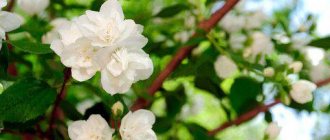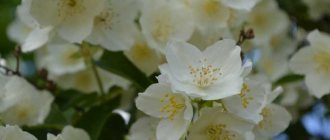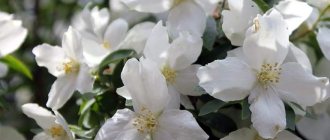Propagating jasmine at home is a great way to get a large number of flowers for your garden without spending extra money. In addition, growing flowers in your garden will not only give you exact copies of your favorite variety, but will also allow you to develop a variety that is resistant specifically to your climate zone.
Jasmine is propagated in four ways: planting seeds, rooting cuttings, division and layering. As a result of each method, you will receive strong, resilient seedlings, which can subsequently be transferred to open ground or to an indoor pot. There are more than 200 varieties of jasmine, each with its own special characteristics, as well as requirements for cultivation, care and propagation.
Frost-resistant species can grow even in northern latitudes, but there are also those that will not survive even minimal frosts on the soil. Before you start growing and propagating jasmine, you should choose the variety that is most suitable for certain climatic conditions. The first brood is obtained thanks to seedlings from the nursery or seeds purchased at the nearest gardening store. So, let's look at all the ways you can propagate garden jasmine.
Propagation of jasmine by seeds
Collecting seeds
How to propagate jasmine from seeds? First you need to collect fresh seeds from the plant. By the end of summer, instead of jasmine flowers, small seed pods similar to bean pods will appear. At the beginning of September, it is already worth taking a closer look at the testes so as not to miss the moment of their final maturation and opening.
If this moment is missed and the pods open, the seeds will be scattered, and collecting them from the ground will become quite a task. Look for pods that turn brown, as this is a sign that they are ripe and about to burst.
Tip: in order not to miss the opening period of jasmine seeds, wrap the pods in a small gauze bag so as not to damage the stem. When the time comes to “burst”, all the seeds will be inside the gauze.
Growing seeds
It is necessary to start sowing seeds at home at least 6 weeks before the expected last frost. If jasmine flowers are used as indoor plants, you can start growing them at any time of the year. Next we perform the following sequence of actions:
- To soften the seed skins a little, soak them in warm water overnight before planting.
- To grow seeds, use a universal soil mixture purchased at a gardening store or prepared soil yourself in the ratio: 2 parts peat, 1 part perlite and 1 part compost.
- Plant the soaked seeds in a pre-prepared soil mixture, drowning them 1-2 cm into the soil and covering them with a small amount of soil on top.
- It is best to plant in shallow, oblong trays , which will be conveniently located on the windowsill, and watering them will not cause trouble.
- Next, the trays should be stored indoors at a temperature of +21-23 degrees. To stimulate the appearance of sprouts, they can be placed on a sunny windowsill for about 6-8 hours a day.
- Watering is carried out regularly, do not let the soil in the trays dry out, but do not overwater.
- Seeds germinate very slowly, and the first shoots can be expected in about 1 month.
Transplanting seedlings from a tray
How to plant jasmine seedlings? When the first shoots reach 5-7 cm in height, the plant should be transferred to a flower pot (if they will be grown indoors) or to a peat pot (if they will be planted in open ground in the future).
It is better to prepare the soil for replanting yourself in the following composition:
- 1 part universal primer;
- 1 part crushed bark;
- 1.5 parts perlite;
- 1 part fresh compost.
Carefully dig up the seedling and transfer it to a pot. Do not compact the soil with your hands, but simply water it generously until the soil settles on its own. Next, water regularly for 2-3 weeks, periodically fluffing the soil.
Attention ! Before the first transplant, carefully inspect each seedling for rotting roots or the appearance of mold or black spots on the plant. Such seedlings are destroyed.
Stimulating rooting
To help the cuttings take root faster, additional stimulation can be applied. For this purpose, there are special preparations on sale that improve the process of root formation - Kornevin, Sodium Humate, Zircon and others. They are used according to the instructions.
The drug "Kornevin"
Jasmine bush: planting and care
There are also folk remedies for this. For example, a solution of succinic acid (1 tablet per liter of water). Cuttings should be soaked in the mixture for 30 minutes immediately before placing in the ground.
Interesting! If the planting material takes root in water, you can add aspirin (5 tablets per 100 ml of water). Aloe juice is also a stimulator for growth processes. To the water for rooting you need to add 6-7 drops of juice squeezed from a ripe leaf.
Propagation of jasmine by cuttings
Jasmine can be propagated by cuttings both in summer and spring:
- Select a healthy, firm stem that has grown this year. A dark green stem with several rows of leaves on it will work best.
- You can take 1-3 seedlings from each donor bush.
- Choose cuttings with a reserve, as some seedlings may not take root.
- For pruning, small garden shears are used to cut stems 10-15 cm long.
- It is best to cut the stem just below the leaf. Roots are more likely to appear if the cut is made directly below a leaf node.
- Remove leaves from the bottom of the cutting. Make sure there are no leaves underground as this will cause the plant to rot. There should be at least 2 leaves left at the top of the cutting.
- Removing most of the leaves helps balance growth between future roots and remaining leaves.
Attention ! Do not use cuttings that have seed pods at the end, as the stem will transfer all the nutrients to the seeds.
To propagate mock orange from cuttings, prepare a container or pot for growing the cuttings. It is best to use a universal nutrient soil that can be mixed with compost in advance. The cuttings are placed at a distance of 3-5 cm. Several cuttings can also be grown in one pot at the same time, and in the future they can be planted. The pot or container must have sufficient holes for drainage.
- Moisten the soil generously with water. You should not water the cuttings after you place them in the soil, since at the very beginning there are no roots that will absorb this moisture.
- Use a pencil or similar thin stick to prepare holes in the soil the size of the cuttings.
- The size of such a hole should be slightly wider than the stem of the cutting (literally a few millimeters).
- The cut end of each cutting is pre-moistened in a special hormone composition to accelerate root growth, and then inserted into the hole. There is no need to keep the stems in this solution. The ideal solution would be to use a dry mixture to stimulate root growth - simply dip the cut into this powder and insert the cutting into the hole.
- Lightly press the soil around the cutting so that it does not wobble in the soil.
- Cover the container with plastic to create a greenhouse effect. Each cutting can be separately covered with a cut plastic bottle. The main thing in this process is that the oilcloth or bottle should not touch the handle, otherwise it will lead to the formation of mold.
- Periodically, 1-2 times a week, open an improvised greenhouse and irrigate the ground with water from a sprayer.
- Cuttings in trays or pots are placed on a sunny windowsill (at least 6-8 hours of daylight).
After 4-6 weeks the plant will finally take root. You can check the number of roots using one cutting from the container. You can transplant into open ground or into another pot for indoor growing. When transplanting, you will be able to inspect the roots of each seedling.
Description and characteristics of the plant
Jasmine belongs to the Olive family and is noticeably different from other representatives of its genus. It grows as an erect or climbing shrub with slender shoots bearing simple, dark green, trifoliate leaves.
During flowering, corymbose inflorescences are formed at the top of the stems, collected from single flowers with a pronounced sweet aroma. Inedible berries are subsequently formed inside the long corollas. The color of the petals can be white, pink and yellow, depending on the variety.
Jasmine
On a note! The flowers of the plant are often added to green tea as an aromatic component, and its essential oil is used to make perfumes.
Jasmine does not require any painstaking care, so summer residents willingly use it to decorate their plots. Today, there are more than 300 species of this shrub in cultivation. The most popular varieties include:
- multi-flowered;
- drug;
- Jasmine Lerata;
- shrubby;
- flattened;
- Chinese;
- sambac.
Most species of this heat-loving crop grow in South America, Africa, Australia, Asia, and the Mediterranean. In Russia and other European countries, only 2 varieties of the plant are grown - bush jasmine with yellow flowers and white medicinal jasmine.
Shrub jasmine with yellow flowers
Reproduction of mock orange by layering
Reproduction by layering is quite simple in 4 steps:
- Bend a branch on the mother bush into a "U" shape so that the leaf node touches the ground. The leaves themselves are removed in this place.
- Press the stem into the ground at the bend with your finger, but do not break it. For fixation, you can use a “U” shaped piece of wire.
- Keep the soil moist but do not overwater. Roots will appear in 2-3 months.
- Wait until the first pair of leaves appears on the cutting, after which you can cut the branch from the mother plant.
Next, transplant the cuttings into a new pot or open ground.
Seedling care
The plant loves maximally moist soil and does not tolerate arid climates. At elevated temperatures, jasmine needs to be watered regularly. After each watering, the soil under the bush must be loosened.
It is recommended to fertilize at least 3 times a year:
- In spring, the soil is fertilized with organic fertilizers (slurry diluted with water in a ratio of 1:10 has proven itself well).
- In summer, nitrogen preparations should be added to the soil. A mixture of urea (15 grams), superphosphate (30 grams), potassium sulfate (15 grams), diluted in 10 liters of water, is suitable.
- After flowering, a mixture of Superphosphate (15 grams) and potassium sulfate (15 grams) will help restore the soil. Dry substances are dissolved in a bucket of warm water. Watering is done directly under the bush.
On a note! Mulching the soil with peat or sawdust will help maintain the required level of moisture.
Healthy flowering plant
Propagation of jasmine by dividing the bush
How does jasmine propagate by dividing the bush? This method is not very popular, since old bushes have a highly branched root system, and removing them from the ground without damaging them becomes quite a difficult task. However, young bushes (1-2 seasons) can be easily divided.
- Dig up the plant bush, shake off the soil from large tubers and jerk all the soil out of the root system. This must be done carefully so as not to damage the roots of the flower.
- Place the bush on a flat surface and try out how best to divide the root. For each bush, the division will be individual and not necessarily in half.
- Divide the bush with your hands so that each part has at least 2-3 full stems.
- Each part of the bush is returned to the soil or pot and watered abundantly.
It is better to divide the bush in the fall. You can carry out the procedure in the summer, the main thing is to do it during the period when there is a minimum number of flowers on the bush. Planting is always carried out in a sunny area. Later, when the plant takes root, it can be transplanted to another location.
Similar articles:
How to propagate Decembrist - several ways
Jasmine and mock orange are subspecies of garden plants
How to propagate currants - the best ways
Post-transplant care basics
Young plants need careful care after transplantation. It is important not only for plants kept indoors. In open ground, cuttings also need to be looked after so that by autumn they become stronger, develop a root system and prepare for wintering.
How to care for jasmine in the garden
Transplanted rooted jasmine cuttings need regular watering.
We must not forget that the root system of the plant has not yet been formed. It is necessary to ensure such a watering regime so that the soil does not dry out, but is not too wet.
It is recommended to loosen the soil around the trunk of a young plant weekly . This procedure retains moisture in the soil well. And when the seedling begins to grow, you can begin to hill it. This has a beneficial effect on the development of the entire plant and strengthening its roots.
Transfer rules
The most bright and sunny place is suitable for transplanting jasmine. The plant responds positively to bright light. With a lack of sunlight, the shoots stretch out, the flowers become smaller or even fall off.
The planting substrate should consist of:
- humus – 1 part;
- river sand – 2 parts;
- leaf soil - 3 parts.
The pit should have a size of 60*60*60 cm. The bottom layer is drainage. You can use gravel or expanded clay, the minimum thickness is 15 cm. On top of the drainage, the recess is filled with the prepared substrate.
On a note! The root collar of jasmine sinks to ground level. Severe deepening can lead to root rot.
After planting, the plant needs to be watered abundantly. Stagnation of water can lead to the death of the bush.
Decorative jasmine bush
Jasmine is a plant that does not require special care and is unpretentious to its growing location. The main thing is to comply with all the rules of growing, watering and fertilizing. As a result, the snow-white bush will ennoble the owner, turning the most ordinary landscape into an exquisite one.
Planting seedlings
Mock orange loves light very much, so it needs to be planted in a place that is illuminated all day long; in the shade its flowers become smaller. The plant also does not like high groundwater levels. Also make sure that the soil acidity is at a neutral level. Plants are planted in a permanent place both in spring and autumn.
Otherwise, the planting of mock orange is not anything special. A planting hole is also dug and a seedling is placed in it. The size of the planting hole and the distance during planting are maintained according to the varietal characteristics, usually from 50 to 150 centimeters. After planting, water thoroughly and mulch the soil.
A year before winter, the mock orange seedling is cut off almost completely at the base, leaving a small stump. This ensures abundant growth of root shoots, which means the bush will be more lush than without pruning.
Excellent video about mock orange:
Moscow, Russia, on the website from 01/11/2017
Have you read it? Don't forget to rate
Loading…
Source
June 29, 2012 / Yulia Popova
When visiting friends during mock orange (garden jasmine) flowering, you probably come across interesting varieties that you would like to plant. Getting your favorite variety is as easy as shelling pears! Ask the owners for permission to tear off a twig for a cutting. You can take semi-lignified cuttings directly during flowering or after it. They take root very easily.











